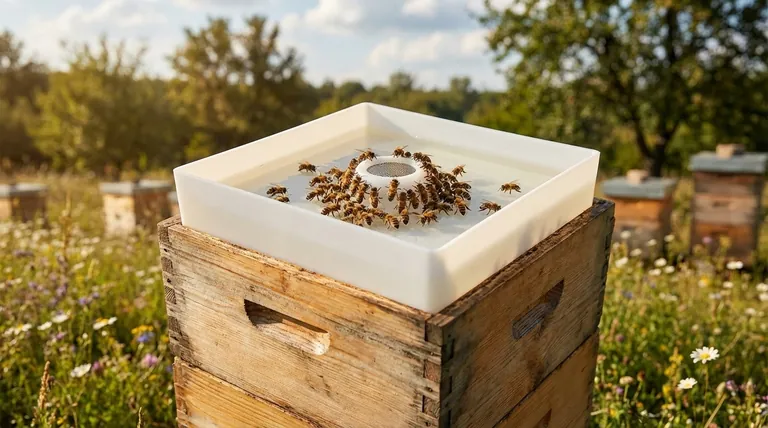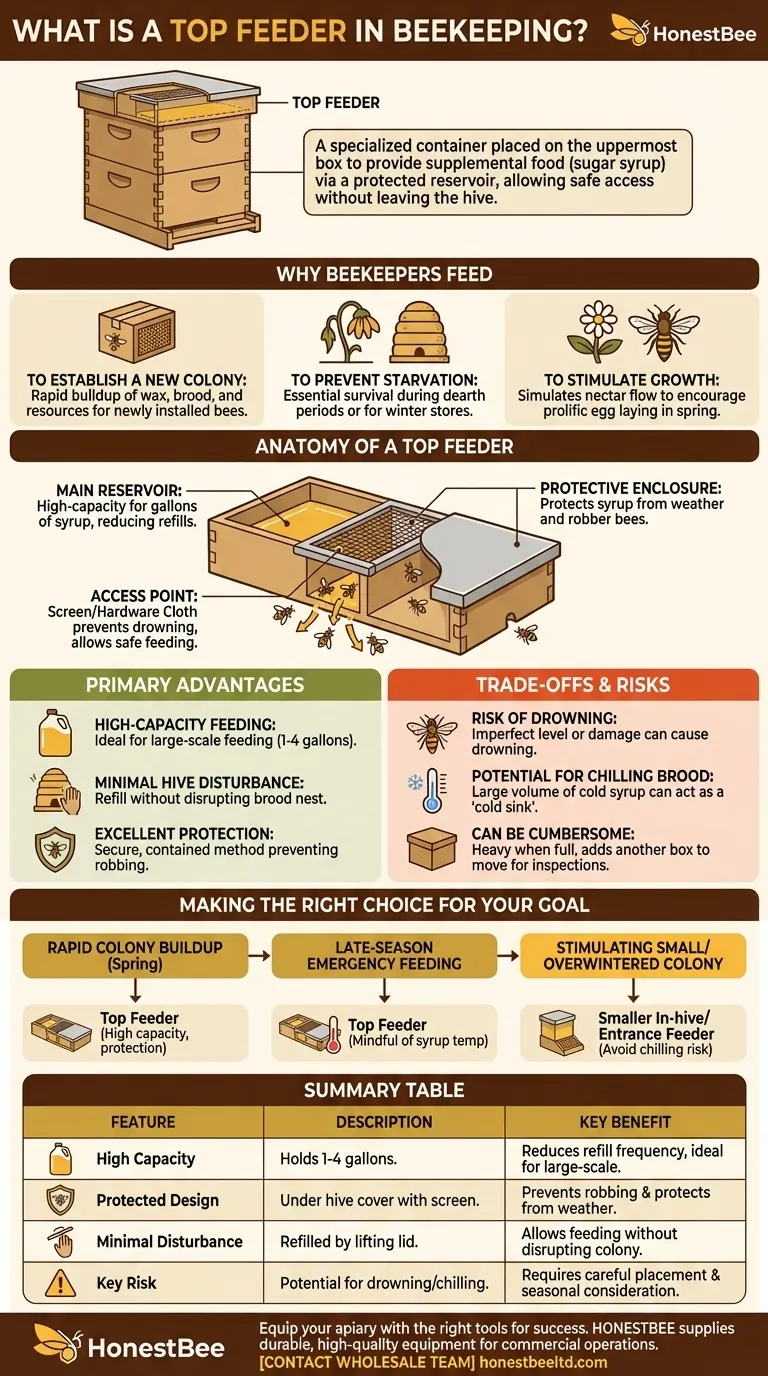In beekeeping, a top feeder is a specialized container placed on the uppermost box of a beehive to provide the colony with supplemental food, typically sugar syrup. It functions as a large, protected reservoir that allows bees to access the feed without leaving the hive, using a screen or similar mechanism to prevent them from drowning.
The core purpose of a feeder is to support a honey bee colony when natural forage is scarce. A top feeder is a high-capacity, low-disturbance tool for this job, but its effectiveness depends on understanding its specific advantages and potential risks.

Why Beekeepers Feed Their Colonies
Before analyzing the feeder itself, it's crucial to understand why supplemental feeding is a fundamental practice in modern beekeeping.
To Establish a New Colony
Newly installed packages of bees or small nucleus colonies have a monumental task: building wax comb, raising young bees (brood), and gathering resources. Providing a steady supply of sugar syrup gives them the energy needed for this rapid, critical buildup.
To Prevent Starvation
Feeding is essential for survival during periods of dearth when no nectar-producing flowers are in bloom. It is also a common practice to ensure a colony has sufficient stores to survive the long, cold winter months.
To Stimulate Growth
Beekeepers can simulate a natural nectar flow by providing light syrup in early spring. This encourages the queen to begin laying eggs more prolifically, leading to a larger workforce in time for the main honey flow.
Anatomy of a Top Feeder
A top feeder's design is straightforward but purposeful, addressing several key challenges of feeding a bee colony.
The Main Reservoir
This is the large, open section of the feeder that holds gallons of sugar syrup. Its high capacity is a primary advantage, as it reduces the frequency of refills compared to smaller feeder types.
The Access Point
The bees cannot be allowed to access the main reservoir, as they would drown. Instead, a central channel or side compartment is covered with a screen or hardware cloth. This allows bees to climb down and drink the syrup safely through the mesh.
The Protective Enclosure
The entire feeder sits on top of the hive but underneath the main hive cover. This placement protects the syrup from being diluted by rain, baked by the sun, or discovered by robber bees and other insects from neighboring hives.
The Primary Advantages of Top Feeders
Beekeepers choose top feeders for several distinct benefits that align with specific management goals.
High-Capacity Feeding
A top feeder can hold one to four gallons of syrup. This is ideal for situations requiring large-scale feeding, such as establishing a new colony or preparing a light hive for winter.
Minimal Hive Disturbance
Refilling a top feeder is a quiet, low-impact process. You can simply lift the hive lid, pour in more syrup, and close it back up, often without using a smoker or disrupting the colony's activity in the brood boxes below.
Excellent Protection
Because the feed is fully contained within the hive stack, it is the most secure method for preventing robbing. Other feeder types, like entrance feeders, can spill syrup outside the hive, which can incite a frenzy of robbing from other colonies.
Understanding the Trade-offs and Risks
While effective, top feeders are not without their potential downsides. Objectivity requires acknowledging these risks to ensure proper use.
Risk of Drowning
Despite the protective screen, bees can still drown. If the feeder is not perfectly level, if the screen is damaged, or if the beekeeper spills syrup into the main hive during a refill, drowning can occur.
Potential for Chilling the Brood
In cooler weather, placing a large volume of cold syrup directly above the brood nest can act as a "cold sink." This can make it harder for the bees to maintain the optimal temperature required for raising young.
Can Be Cumbersome
A top feeder is essentially another box that must be removed every time you want to inspect the frames below. When full of syrup, it can be heavy and awkward to handle.
Making the Right Choice for Your Goal
Selecting a feeder depends entirely on your specific objective for the colony at that moment.
- If your primary focus is rapid colony buildup in spring: A top feeder is an excellent choice due to its high capacity and protection from robbing.
- If your primary focus is late-season emergency feeding: A top feeder is effective, but be mindful of the syrup temperature to avoid chilling the brood.
- If your primary focus is stimulating a small, overwintered colony: A smaller in-hive or entrance feeder may be a better choice to avoid the risk of chilling.
Ultimately, understanding the design of a top feeder transforms it from a simple container into a strategic tool for precise colony management.
Summary Table:
| Feature | Description | Key Benefit |
|---|---|---|
| High Capacity | Holds 1-4 gallons of syrup. | Reduces refill frequency, ideal for large-scale feeding. |
| Protected Design | Placed under the hive cover with a safety screen. | Prevents robbing and protects syrup from weather. |
| Minimal Disturbance | Refilled by simply lifting the hive lid. | Allows feeding without disrupting the colony below. |
| Key Risk | Potential for drowning if not level; can chill brood in cool weather. | Requires careful placement and seasonal consideration. |
Equip your apiary with the right tools for success.
As a commercial beekeeper or distributor, efficient colony management is key to your productivity and profitability. HONESTBEE supplies the durable, high-quality beekeeping equipment you rely on, including top feeders designed for commercial-scale operations.
Contact our wholesale team today to discuss your needs and discover how our products can support the health of your colonies and the growth of your business.
Visual Guide

Related Products
- HONESTBEE Professional Hive Top Bee Feeder Feeding Solution
- Professional Hive Top Bee Feeder for Beekeeping
- HONESTBEE Round Hive Top Bee Feeder for Syrup
- Rapid Bee Feeder White Plastic 2L Round Top Feeder for 8 or 10-Frame Bee Hives
- Professional Hive Front Entrance Bee Feeder
People Also Ask
- Why is a top feeder essential for bees? Ensure Colony Health and Efficiency
- What is the best way to top feed bees? A Safe, High-Volume Feeding Solution for Your Apiary
- Do I need an inner cover with a hive top feeder? Optimize Your Hive Setup for Healthy Bees
- What should be done with feeders and equipment after feeding bees? Essential Steps for Apiary Health
- What are the advantages of hive top feeders? Maximize Feeding Efficiency for Your Apiary



















